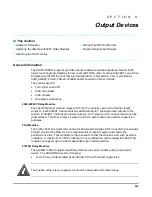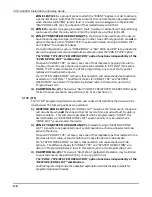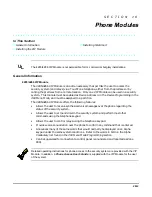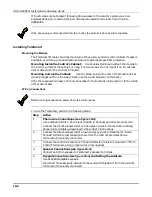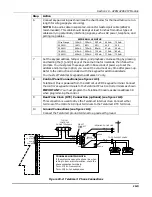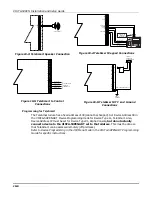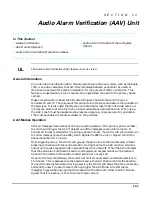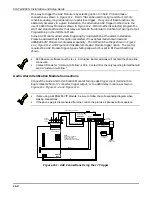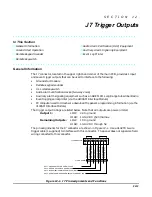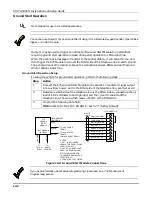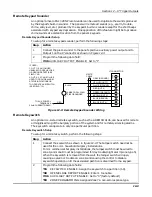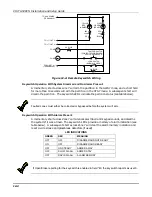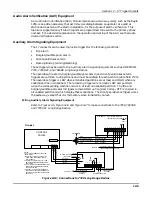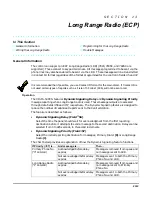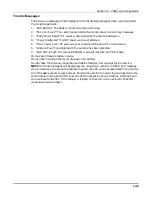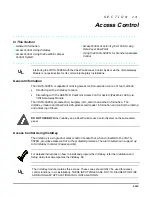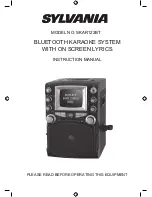
11-1
S E C T I O N 1 1
Audio Alarm Verification (AAV) Unit
• • • • • • • • • • • • • • • • • • • • • • • • • • • • • • • • • • • • • • • • • • • • • • • • •
In This Section
♦
General Information
♦
AAV Module Operation
♦
Audio Alarm Verification Module Connections
♦
Audio Alarm Verification Module Program
Options
• • • • • • • • • • • • • • • • • • • • • • • • • • • • • • • • • • • • • • • • • • • • • • • • •
UL
The Audio Alarm Verification (AAV) feature is not UL Listed.
General Information
An Audio Alarm Verification (AAV) Module (also known as two-way voice), such as the Eagle
1250, is an add-on accessory that permits voice dialog between an operator at a central
station and a person at the alarm installation, for the purpose of alarm verification. This
feature is supported only if Alarm reports are programmed to be sent to the primary phone
number.
Make connections from Eagle 1250 Module terminals 7 and 8 to the control's zone 5
terminals 16 and 17. The purpose of this connection is to silence and restore the sounders at
the premises. It is also used to postpone noncritical dialer reports while the AAV session is
in progress. Note that zone 5 is then no longer available as a protection zone. When using
the AAV, zone 5 must be assigned a zone response type (e.g., response type 10), and option
1*60 must be enabled to silence sounders on the premises.
AAV Module Operation
After all messages have been sent during a reporting session to the primary phone number,
the control will trigger the AAV if at least one of the messages was an Alarm report. If
Contact ID format is selected for the primary phone number, the control will send a Listen-in
to Follow message (Event Code 606), which signals the 685 (rev. 4.6 or higher) to hold the
phone connection for 1 minute.
Once triggering occurs, the control will give up the phone line to the AAV Module, without
breaking connection with the central station. During the time the AAV is active, all sirens
and all continuous keypad sounds in all partitions will be shut off. When the AAV indicates
that the audio alarm verification session is completed, all keypad sounds will be restored.
Sirens will be restored if the alarm timeout period has not expired.
As part of its fail-safe software, the control will limit all audio alarm verification sessions to
15 minutes. This is because once the session begins, the AAV Module controls the duration.
If a new fire alarm should occur during a session, the control will break the phone connection
and send the new Fire Alarm report, then re-trigger the AAV Mode. All other dialer
messages triggered during ongoing conversation will be held until either the AAV Module
signals that it is inactive, or the 15-minute timeout occurs.
Summary of Contents for VISTA-50PEN
Page 2: ...ii...
Page 10: ...VISTA 50PEN Installation and Setup Guide x...
Page 26: ...VISTA 50PEN Installation and Setup Guide 3 4...
Page 42: ...VISTA 50PEN Installation and Setup Guide 6 6...
Page 56: ...VISTA 50PEN Installation and Setup Guide 8 8...
Page 82: ...VISTA 50PEN Installation and Setup Guide 13 4...
Page 110: ...VISTA 50PEN Installation and Setup Guide 18 8...
Page 118: ...VISTA 50PEN Installation and Setup Guide 20 4...
Page 138: ...VISTA 50PEN Installation and Setup Guide 22 18...
Page 166: ...VISTA 50PEN Installation and Setup Guide 25 6...
Page 172: ...VISTA 50PEN Installation and Setup Guide 27 2...
Page 186: ...VISTA 50PEN Installation and Setup Guide 29 8...
Page 192: ...VISTA 50PEN Installation and Setup Guide 30 6...
Page 197: ...B 1 A P P E N D I X B DIP Switch Tables...
Page 200: ...VISTA 50PEN Installation and Setup Guide B 4...
Page 214: ...l K3271 1BX 9 00 165 Eileen Way Syosset NY 11791 Copyright 2000 PITTWAY Corporation...



